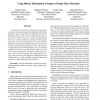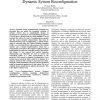695 search results - page 82 / 139 » Studying the Evolution of Software Systems Using Change Clus... |
AOSD
2005
ACM
14 years 1 months ago
2005
ACM
Even when working on a well-modularized software system, programmers tend to spend more time navigating the code than working with it. This phenomenon arises because it is impossi...
HPCA
1999
IEEE
13 years 12 months ago
1999
IEEE
Symmetric multiprocessors (SMPs) connected with low-latency networks provide attractive building blocks for software distributed shared memory systems. Two distinct approaches hav...
CSMR
2004
IEEE
13 years 11 months ago
2004
IEEE
1 As systems evolve and their structure decays, maintainers need accurate and automatic identification of the design problems. Current approaches for automatic detection of design...
PPPJ
2009
ACM
14 years 2 months ago
2009
ACM
Repository-based revision control systems such as CVS, RCS, Subversion, and GIT, are extremely useful tools that enable software developers to concurrently modify source code, man...
JSW
2008
13 years 7 months ago
2008
Dynamic system reconfiguration techniques are presented that can enable the systematic evolution of software systems due to unanticipated changes in specification or requirements. ...


